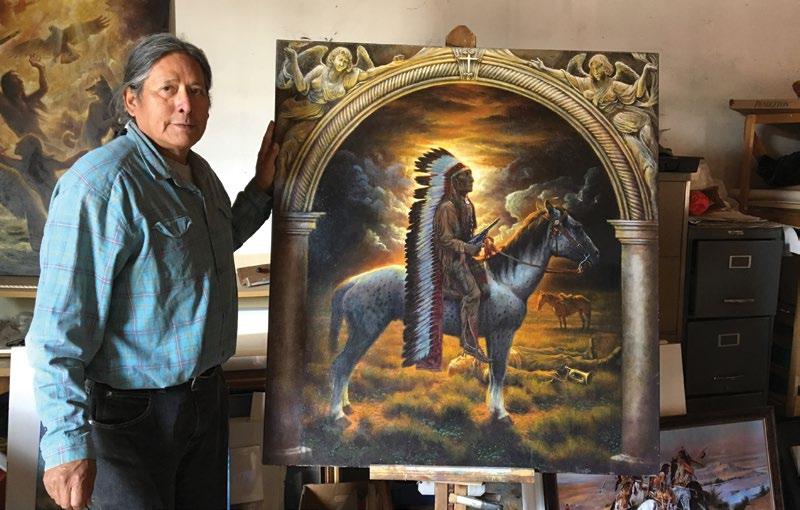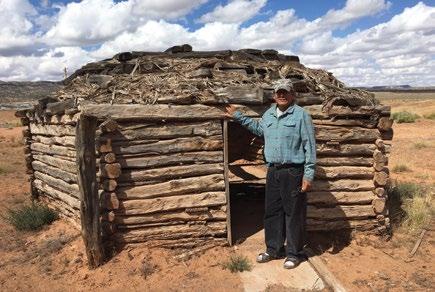
4 minute read
Redwing Nez: A Diné Renaissance Man and Artist of Many Talents
By Tom Surface
Renowned artist, traditional Diné sandpainter, author, conservationist, and even movie actor, Redwing Ted Nez is an individual of many talents. An artist with wide-ranging skills and well known for his traditional paintings, murals and illustrations, he is also noted for his contemporary oil and acrylic paintings.
Born in 1960 and raised on the Navajo reservation in northern Arizona, he trained as a traditional sandpainter. His paternal grandfather was a “healer” and as a 9-year-old, Redwing was called on to help with drawing sandpaintings on the ground for various traditional Diné ceremonies.

Redwing’s latest work, “Light Within Men”
PAINTING FOR TRADING
It was the Bita Hochee Trading Post operator in the mid-1960s that set a very young Redwing on his path as an artist. “The trading post had a shiny toy pistol that I really wanted. So speaking in Navajo, the old trader offered to trade for the toy pistol if I made a weaving. I soon realized I could not weave, so I started drawing. The trader worked with me and suggested new colors and symbols,” he explained. The deal was finally made and he got his pistol.
But it was his maternal grandmother who opened his eyes to the beauty of painting and colors. “My grandma had a book of Renaissance artists and their colorful paintings. And our preacher also had a gold covered book with paintings that I would look at. I then went to work trying to match all those bright colors and skin tones using my crayons,” Redwing added.
Redwing notes that the first real promoter of his art was Joseph Pepe’ Masis, who came to this country as a student from Costa Rica. He later served in the U.S. military in Vietnam and worked for years with railroad company Conrail. Masis invested in railroad stock and later would come into Redwing’s studio and buy everything he had. “He did this for several years and sold my works to galleries and collectors,” said Redwing. “I was suddenly getting my work recognized both in the U.S. and even overseas.” Masis is also the person who first encouraged Redwing to save and revitalize the old Bita Hochee Trading Post.
Redwing and his works achieved widespread notoriety as the profiled artist in the November 1994 issue of Southwest Art Magazine, where the editors also took note of his emerging artistic career. His complex contemporary works draw from Redwing’s Diné (Navajo) heritage and include imagery and symbols such as birds and corn stalks, symbols of the four seasons, rainbows and lightening. In the visually striking canvasses, cornstalks frequently play a central role. “We worship white corn,” he explains; “morning corn, the corn of life. It’s a prayer, a chant.”
He has exhibited and won numerous awards in shows throughout the American Southwest, including at the prestigious Santa Fe Indian Market and at the Museum of Northern Arizona. He also is the author and illustrator of Forbidden Talent, a children’s book about a young Navajo boy who loved to create art. Oh yes, he also appeared as a Sioux warrior in 1990 classic film “Dances with Wolves.”

Redwing shows an old Hogan on the grounds of The Bita Hochee Trading Post
GROWING NOTORIETY
In the years since his profile in Southwest Art Magazine, Redwing has earned a number of major commissions including his work for Mesa Verde National Park in Colorado. Redwing was commissioned to paint “Dwellers of the First World,” a 52” x 48” oil on canvas painting depicting the Anasazi who lived in Mesa Verde circa 1200 A.D. This work now adorns the Visitors Center at the park. He was also selected to create a mural commemorating the 2012 State of Arizona Centennial. Nez was commissioned to paint the 60-foot long mural that now graces the wall along Centennial Walkway facing Flagstaff’s historic train station, on Route 66, where the Flagstaff Visitor Center is located.
In the project of selecting a Centennial artist for the significant and very public assignment, “Redwing’s submission was absolutely the very, very best,” said acclaimed Grand Canyon artist Bruce Aiken, who chaired the commission. “He’s a very accomplished muralist and a highly skilled painter, and we’re thrilled to have him as the centennial muralist for Flagstaff.” In the mural, the largest Nez had ever done, the cultural, historic and natural aspects of what it means for people living in Flagstaff are depicted. Next, Redwing plans to begin work on an initiative for the Gene Autry Museum of the American West in California. Redwing prefers the traditional painting designs and media as opposed to some of the more modern graffiti-style that is more in vogue today. “I want to enlighten people on our history, culture, and heritage,” he states.
Redwing Nez currently works out of his studio in the now-defunct Bita Hochee Trading Post, built around 1870 on the Navajo reservation. He knows intimately the red rocks and buttes that define this striking area. The once thriving center of so much social activity for the Diné was slated to have its neglected buildings razed but Redwing single-handedly stood off the bulldozers. It is his strongest desire that the buildings be restored and reborn as an artistic and cultural center that can, once again, become an integral part of life for the Diné people. Today, Redwing Nez’s works can be found in galleries throughout the Southwest or you can reach out to him directly via his e-mail: bitahochee_paint@yahoo.com.

Redwing posing with his recent work, “Winter Dance of the Night Way”
By Tom Surface



